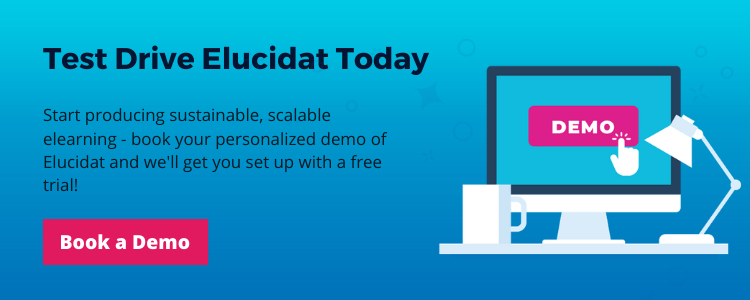Profile of a modern learner: an infographic
9 minute read
Meet the modern learner. Busy, savvy and hungry to learn. But are they getting what they need? We’ve pulled together findings from numerous research papers and surveys to help you get to grips with what modern professionals need. Use these insights to make sure your learning solutions will cut through the noise and help people when, where and how they need it.

Our original ‘Profile of a modern learner’ infographic and blog was published in June 2016.
This new version was created with the latest insights in August 2018.
The modern learner – busy, savvy, and hungry to learn
The terms used by Josh Bersin to describe modern learners still hold. They are still ‘overwhelmed, distracted and impatient’ (Bersin by Deloitte). But, they are also hungry to learn and keen to grow their skills to the point that if an organisation isn’t enabling them to develop professionally, they’ll up and leave. That’s right, according to Fosway, learning and development opportunities are the #1 attraction to working somewhere, and can make or break employee retention and performance. But the learning and development opportunities have to be good.
The modern learner is savvy – hunting out the best answers to their problems, in the moment of need, mostly on Smartphones. Learning content has to be useful and relevant to engage them.
Sadly, many aren’t finding what they need in their workplace.
The modern learner also has an eye on the future. In an era of rising AI, more fluid job roles and rising contractors, people are reaching out for the kinds of skills that will do them well in the future. Whilst hard skills are, perhaps sensibly, focused on data analytics and machine learning, soft skills are tipping the balance in lists of more popular online courses. What’s interesting is that they feature skills such as ‘emotional intelligence’ and ‘critical thinking’ – skills that the bots can’t offer? – but also ‘learning how to learn’.
It seems that the modern learner is crying out to self-develop, but needs extra empowerment and support from their workplaces to figure out how, and where, to go.
Here’s the detail and sources behind the facts and stats we’ve shared.
The modern learner is…
1. Overwhelmed and distracted
In Insights from IMPACT 2018, Josh Bersin shared that the average worker spends 25% of their time on emails and checks their phone 150 times a day. We spend around 35% of our working week in meetings with more than half deemed unproductive (The Muse). And, on top of that, we are interrupted around 56 times a day (Atlassian). Being productive is challenging!
Meanwhile, the average time people have put aside to learn for work, is around 20 mins a week (Bersin & Forbes). A mere 1%. It’s no wonder people are begging for targeted, timely learning content.
2. Keen to learn
Professional development opportunities are essential for attracting and retaining people to organisations. Not only is it the #1 attraction to working at an organisation (Fosway), other studies, such as this one from Brand Learning, show how learning is essential to employee engagement, and in turn, essential to growth in business performance.
According to LinkedIn 2018 Workplace Learning Report, 94% of employees would stay at a company if it invested in their career development.
But it’s not always the case that people are getting what they want. In their 2018 Benchmark Report, Towards Maturity report that only:
- 15% can access learning directly relating to their job
- 10% can determine own path through learning
3. Wants personalized, timely, quality content
Relevance is king. The majority of workplace learning is done in the moment of need. And, according to Treion Muller’s 7 Consumer Realities report, in moments of need 96% of people turn to their phones and search for the answer.
What’s more, increasingly people are getting more focused on quality and relevance. Think with Google reports that mobile searches that include the term “best” and “____for me” have grown by 80 and 60% respectively, in the last two years. People are hunting for the most useful answers, and stripping out what’s not helping them.
On top of that, the average person gives content around 7 seconds to decide if a page of content is for them or not, and 70% of users will leave if it’s not optimised for them and their needs.
4. Learns as needed, anywhere, anytime
According to Towards Maturity’s Bridging the Divide report, which has researched the movements of 43,000+ workplace learners since 2003, over half of people learn at the point of need. This takes the lion’s share of the survey. We understand from Treion Muller’s 7 Consumer Realities, that the majority of users in this case turn to their smartphones for this.
Mobile learning is also popular with those on commutes, with around a third of people learning whilst they travel to and from work. But there’s still a substantial amount (41%) that learn at their desks. Is this an indication that not all content is optimised for mobiles, or the reality that this is where many people are working and so are switching to learning through on the job experience and where it’s convenient? It could also be because a lot of learning needs dedicated focus and is easier to do on a larger screen.
5. Turn to their phones
We don’t really have to report on the smartphone revolution. It’s pretty obvious these days! But it does help to frame just how distracted and bombarded modern learning audiences are to report on some of the stats.
The average person spends 2 hours a day on their smartphone. This rises to 3 hours for 18 – 24 year olds (Time to log off). The addictiveness of smartphone and social media use is now being recognised by health organisations, like the NHS, who offer treatment for it. The average person checks their phone around 10 times an hour (Bersin).
It’s no surprise that in moments of need we turn to our beloved pocket friends for help when it comes to learning.
6. Prefers learning to be through on the job experience
Without a doubt, the majority of people prefer to learn through on the job experience (93%). This comes out top in both the user research conducted, independently, by Jane Hart and Towards Maturity. In fact, 93% of employees want to integrate learning and work (Treion Muller), to up their ability to learn through on the job experience and be more efficient.
Combining the findings of both Jane Hart’s and Towards Maturity’s reports, we get a list of preference that looks like this:
- Learning through on the job experience: 93%
- Collaboration and knowledge sharing: 90%
- Google and online resources: 76%
- Manager support: 74%
- Coaching & Mentoring: 65%
- Job aids and guides: 60%
- Classroom: 61%
- Online self-study/elearning: 49%
- Webinars: 44%
- Videos: 40%
Collaboration and knowledge sharing takes silver, and is probably no surprise as learning from and with others is natural, and highly effective. We’re used to turning to others’ for advice in the workplace and this is now easier and more widely cast through the use of social networking tools, like Slack.
Google and online resources are equally of no surprise as high rankers, but the need for manager support may be one that’s not respected enough in workplace L&D. Only 4% of L&D teams provide managers with resources to support their teams with their learning. according to Towards Maturity’s 2018 Benchmark Report. Yet we hear time and time again how imperative managers are to employee engagement and retention, and have already noted how important learning is to these outcomes too. It seems crazy that learning initiatives and manager support aren’t knotted together in L&D strategies.
Classroom learning is a challenging one. Towards Maturity find 63% of people find it a useful form of learning, whereas Jane Hart reports that just 31% users find it very important or essential. However, Towards Maturity’s survey involved 10,000 users as opposed to the 2000 surveyed by Jane. So the average comes in around 61%.
Self paced elearning is considered essential or very useful by around 49% of users, based on the same logic as above.
7. Most values quality, ease of use and relevance in online learning…
In online learning, users most value quality, ease of use and navigation, and relevance and timeliness. These findings back-up the idea of modern learners being savvy filters of ‘what’s giving them value, now’ as they swiftly and automatically assess if content is worthy, in those first 7 seconds.
Similarly, around 55% of modern learners desire personalized learning, which fits with the idea of ‘right stuff, right time to help me’.
All of these stats come from Towards Maturity’s Modern Learning Content report.
8. Seeks out learning on soft skills
Combining the lists of most popular courses from Coursera, LinkedIn Learning and Lynda.com, we found that last year, soft skills training weighed in strongly for modern learners.
What’s really interesting is how the list of top soft skill courses highlight modern learners as people empowered and willing to improve and promote themselves. ‘Body language’, ‘Acing your interview’, ‘Negotiating your salary’ were some of the courses listed in Lynda.com’s top 25. These were alongside ‘Emotional intelligence’, ‘Critical thinking’ and other leadership-themed subjects, which show modern professionals as people preparing for their futures and looking to develop deep problem-solving qualities.
Ranking in the top 3 subjects taken via Coursera last year is ‘Learning how to learn’. We know modern learners are keen to learn, but is this telling us they don’t know how? Perhaps a comment on modern-day education systems, there’s signs that performance consultants and training professionals need to help coach, support and empower modern day users to develop professionally.
9. Motivated to learn because they want to do better and be more productive
Finally, we come to what most motivates modern learners to learn. Ranking way higher than hard-edged reasons such as promotion or salary increases, modern day professionals are keen to learn primarily so they can do their jobs better and be more productive, and for the innate value within learning itself. Learning brings pleasure, a sense of worth, and has value in itself.
It’s no wonder, when done right, it boosts employees’ sense of engagement and performance.
Final thoughts
The modern learner may be busy and overwhelmed, but they are hungry to learn and savvy around they type of content that will help them get there and the skills they deem important for the future.
To engage modern learners, performance support and training and development opportunities need to empower professionals to develop their skills easily and flexibly. Learning content must be easy to find, personalized, fit for purpose and help them in those crucial moments of need. Modern L&D is also about enabling people to learn whilst working. Check our our best elearning practice tips guide for more insights.
Yet, findings from Towards Maturity Benchmark Report 2018 show that only 1% of users are involved in the design of their learning, and just 10% say they can determine their own path through learning content provided.
Discover the secrets to successful elearning development here.
We can help you do it!
What can you do to develop the kind of modern, people-centred learning experiences users need? Elucidat can help! Book a demo today and get in touch with elearning experts.
References
- Atlassian: Stop wasting time at work
- Josh Bersin: Insights from IMPACT 2018
- Bersin by Deloitte: Meet the Modern Learner
- Bersin & Forbes: Watch our Corporate Learning Here Comes Disruption
- Brand Learning: Growth Drivers Study Report
- Coursera: 10 most popular courses in 2017
- Fosway: Revolutionising the Learning Experience 2018: webinar recording
- Jane Hart: Introduction to Modern Workplace Learning in 2018
- LinkedIn: 2018 Workplace Learning Report
- Lynda.com: The 25 Most Popular Online Classes this Year
- The Muse: How much time do we spend in meetings?
- Think with Google: Consumer Insights: Meeting Consumer Expectations
- Time to log off: How much time are you spending on your smartphone?
- Treion Muller: 7 Consumer Realities that the Learning Industry Can No Longer Ignore
- Towards Maturity: The Transformation Curve: 2018 Learning Benchmark Report
- Modern Learning Content 2017
- In focus: Bridging the Divide 2018




